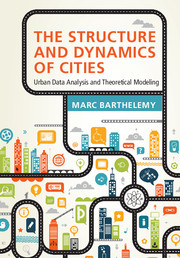Book contents
Preface
Published online by Cambridge University Press: 10 November 2016
Summary
Most of the world's people are now living in cities and urbanization is expected to keep increasing in the near future. The resulting challenges are complex, difficult to handle, and range from increasing dependence on energy, to the emergence of socio-spatial inequalities, to serious environmental and sustainability issues. Understanding and modeling the structure and evolution of cities is then more important than ever as policy makers are actively looking for new paradigms in urban and transport planning.
The recent advances obtained in the understanding of cities have generated increased attention to the potential implication of new theoretical models in agreement with data. Questions such as urban sprawl, effects of congestion, dominant mechanisms governing the spatial distribution of activities and residences, and the effect of new transportation infrastructures are fundamental questions that we need to understand if we want a harmonious development of cities in the future, from both social and economic points of view.
Cities were for a long time the subject of numerous studies in a large number of fields. Discussion of the ideal city can be traced back at least to the Renaissance, and more recently scientists have tried to describe quantitatively the formation and evolution of cities. Regional science and then quantitative geography addressed various problems such as the spatial organization of cities, the impact of infrastructures, and transport. It is remarkable to note that as early as the 1970s quantitative geographers realized the crucial importance of networks in these systems, and produced visionary studies about networks, their evolution, and the complexity of cities (Haggett et al. 1977).
These studies were further developed mathematically by economists who discussed the interplay between space and economic aspects in cities. Many important models find their origin in the seminal paper of Von Thunen and describe isolated, monocentric cities in terms of utility maximization subject to budget constraints. These models allowed spatial economics to get a grasp of the relations between space, income, and transportation; for example. Japanese economists Fujita and Ogawa discussed the impact of agglomeration effects between firms in a general model that deals with the location choice for individuals and companies.
Information
- Type
- Chapter
- Information
- The Structure and Dynamics of CitiesUrban Data Analysis and Theoretical Modeling, pp. xi - xviPublisher: Cambridge University PressPrint publication year: 2016
